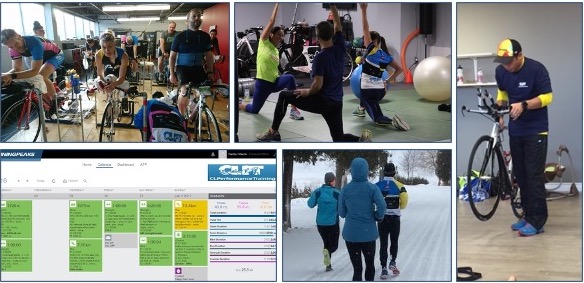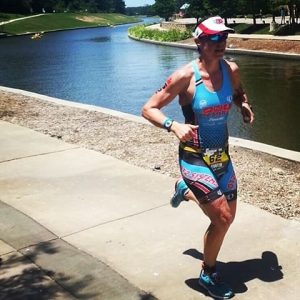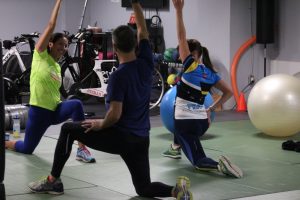Re=-posted for 2023.
Fall and early winter is a great time to reflect on your goals and lay down a plan to give structure and purpose to your training. Your annual training plan should include a periodized plan that includes structured base, build and preparation phases. Here is what to expect.
Ironman – Specific structured training should start at least eight months out from your target race, assuming you already have some degree of fitness and skill in each of the three disciplines. Athletes thinking of doing more than one Ironman in a season would be wise to select an early race in May/June then wait until August/September to race again. This gives you a chance to recover from the first one, put in at least a couple of training blocks to gain fitness and then taper for the next one. At minimum, Ironman’s should be fourweeks apart for an age group athlete who cannot focus 100% on recover, but that is still pretty close together for most athletes.
Half-Ironman – Specific structured training should begin at least six months ahead of a half iron distance, assuming you already have base of fitness and skills is sufficient for the distance. Many athletes choose to do the 70.3 early in the season and continue building to the full Ironman three or four months later. Recovery time between 70.3 races should also be four weeks or more apart, at least if you intend to race both (vs using one as a training race). It is possible to do them closer together – but most age group athletes don’t have the lifestyle that allows them to spend enough time on recovery to give a best effort for half iron distance closer together than that.
Sprint and Olympic triathlon/duathlon – Athletes training for long course triathlon can use shorter races effectively to sharpen their transition skills, practice taking in nutrition, test out gear and gain race experience. Sometimes they can be built into the plan in a way that allows for a great fast performance, but often they function better as training races, where a taper and recovery doesn’t have to be built into the plan as well, so the effort and recovery time won’t interfere with the progress of the long course training. However, if you do choose to race the shorter distances looking for peak performance, you should realize that the short or Olympic distance races require an entirely different kind of training than you’ll be doing with a focus on longer course racing.
Marathon and Half-Marathon – A typical training program of a specific 13 weeks on a base of run fitness will prepare an athlete to race. A taper for marathon should typically be 10-14 days and for a half marathon 7-10 days. If a marathon or half marathon is your “A” goal for the season, shorter races of 5k’s along the way are great ways to gain race experience, give a big hard effort with other people there to motivate you, and practice your race day nutrition plan. 10km races are okay as well, however they will require more recovery time, which may interfere with the training progression for the longer distances.
Training blocks are generally built as three weeks of progressive build, with one week for recovery. Between October and December, expect to have two to three training blocks focused on building your low-end base, speed skills and strength. This phase can feel tedious, but it’s really important for laying the foundation for the rest of your training, no matter what kind of athlete you are or how many years you’ve been doing it.
From February to April, the training blocks will include more anaerobic endurance sets, power or speed intervals. By May and June, the training blocks will require higher efforts for longer periods of time, and short periods of high intensity. From there on, and through race season, you will be given more race specific and skill specific efforts based on your individual needs, type of event and race schedule, balanced with taper and recovery time around your races.
Tapering before races can differ between athletes, depending on individual taper response. Some athletes need a three-week taper before an Ironman/70.3 or two weeks before a marathon/half-marathon. However, some athletes feel flat with a taper that long, and find they perform better with less. This is where having race experience is useful for understanding your individual response. Age also factors into the process of both tapering and recovery. Masters athletes may need more frequent rest or recovery days in order to maintain their optimal performance.
Swimming – With uncertain times ahead, having access to a pool for swim training may be challenging for some triathletes. Maintaining strength using swim bands is important to help keep your form and strength but won’t truly prepare you with swim fitness. The good news is, with some consistent swims when the weather warms up, you will be able to swim your race distance with six to eight weeks of open water training. It might not be your best-ever swim time, but you will be able to pull off a decent swim if you can put in the time in those last couple of months.
Duathlon – If swimming isn’t going to work for you this year (or ever!), duathlon is an option. Like short distance triathlon, training for duathlon requires some specific training in order to get those legs conditioned to run before riding, then run again afterwards. To be truly race ready, you’ll need to have trained to handle this.
Dr. Cindy Lewis-Caballero is the founder of CL Performance Training. She is an endurance coach, a Chiropractor, a personal trainer, a former professional triathlete, and a mom. She works with athletes of all abilities and ages to help them stay motivated and able to go after their personal goals.



